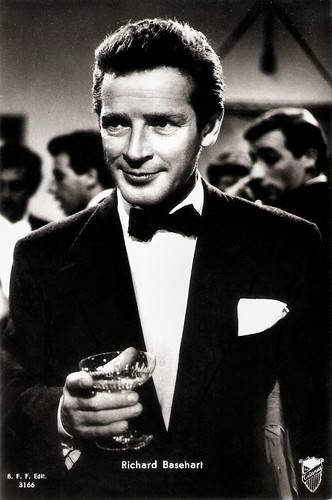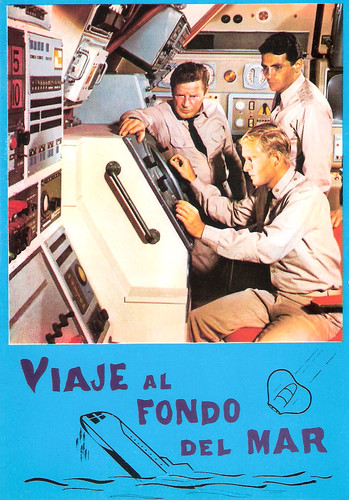
Italian postcard iby B.F.F. Edit., no. 3166. Photo: Titanus. Publicity still for Il Bidone (1955).

Giulietta Masina. Dutch postcard by Uitg. Takken, Utrecht, no. 3381. Photo: N.V. Standaardfilms. Publicity still for La strada (1954).
La Strada
John Richard Basehart was born in Zanesville, Ohio, U.S. in 1914. He spent a part of his childhood in an orphanage after the death of his mother, when his father, Harry Basehart, found himself unable to look after the four children left in his care. The younger Basehart considered a career in journalism like his father, but when he was 13, he began acting in small roles in a local theatre company and came to enjoy performing. In the mid-1930s, he joined Jasper Deeter's famed Hedgerow Theater company in Rose Valley, PA. By the end of the 1930s, he'd set his sights on a Broadway career and moved to New York.
During the 1939 season, while working in stock, Richard Basehart met an actress named Stephanie Klein, and the two were married in early 1940. He continued trying to establish a foothold in New York and in 1942, joined Margaret Webster's theatre company. In 1945 director Bretaigne Windust cast him in the central role of the proud, dying young Scottish soldier in the play 'The Hasty Heart'. Basehart won the 1945 New York Drama Critics Award for his performance and was named the most promising newcomer of the season. In 1947, Basehart moved to Hollywood. He had his breakthrough as the killer in the gritty Film Noir He Walked by Night (Alfred L. Werker, Anthony Mann, 1948). Variety reviewed: “High-spot of the film is the final sequence which takes place in LA's storm drainage tunnel system where the killer tries to make his getaway. With this role, Basehart establishes himself as one of Hollywood's most talented finds in recent years. He heavily overshadows the rest of the cast, although Scott Brady, Roy Roberts and Jim Cardwell, as the detectives, deliver with high competence.”
Next Basehart played a psychotic member of the Hatfield clan in Roseanna McCoy (Irving Reis, 1949), starring Farley Granger. Then he appeared in the Film Noir Fourteen Hours (Henry Hathaway, 1951), as an unhappy man who threatens suicide by standing on the ledge of a high-rise building for 14 hours. During the filming, Basehart's wife Stephanie was taken ill with what proved to be a brain tumour, and died very suddenly. Devastated, he finished work on the film. Roles followed in the war drama Decision Before Dawn (Anatole Litvak, 1951) with Oskar Werner, and the Film Noir The House on Telegraph Hill (Robert Wise, 1951). He fell in love with his co-star in this film, Italian actress Valentina Cortese. They married and would have one son, actor Jackie Basehart.
In Italy, Richard Basehart played one of his most notable film roles, the acrobat known as ‘the Fool’ in the acclaimed Italian film drama La Strada (Federico Fellini, 1954). The film portrays a brutish strongman (Anthony Quinn) and the naïve young woman (Giulietta Masina) whom he buys from her mother and takes with him on the road; encounters with his rival the Fool (Richard Basehart) end with their destruction. The film premiered at the 15th Venice International Film Festival in 1954 and won the Silver Lion. In 1956, it won the inaugural Academy Award for Best Foreign Language Film. Basehart worked again with Fellini on Il bidone/The Swindlers (Federico Fellini, 1955) co-starring Broderick Crawford and Giulietta Masina. Il bidone continues with many of the same socially conscious, neorealist-inspired themes.
The next year, Basehart played Ishmael in Moby Dick (John Huston, 1956), the film adaptation of Herman Melville's novel Moby-Dick. In Spain, he made the comedy Los jueves, milagro/On Thursday, miracle (Luis García Berlanga, 1957), about some people in a small village who decide to fake a miracle in order to increase the tourism but things don't go as planned. He was also one of the brothers in The Brothers Karamazov (Richard Brooks, 1958), based on Fyodor Dostoevsky's novel. In 1960, Basehart and Valentina Cortese divorced. She had left him and moved back to Italy with their young son. For months Basehart had a standing phone call in to Italy, but Valentina never answered it.

British postcard in the Picturegoer Series, London, no. W 884. Photo: Universal International.
Voyage to the Bottom of the Sea
Richard Basehart starred as Adolf Hitler in Hitler (Stuart Heisler, 1962). The film depicts Hitler through the years, beginning with the Beer Hall Putsch of November 1923 and focuses mainly on his private life, in particular, his relationships with niece Geli (Cordula Trantow) and long-time companion, Eva Braun (Maria Emo). From 1964 to 1968, he played the lead role, Admiral Harriman Nelson, on Irwin Allen's first foray into science-fiction television, Voyage to the Bottom of the Sea. The 110 episodes produced included 32 shot in black-and-white (1964–1965), and 78 filmed in colour (1965–1968). The first two seasons took place in the then future of the 1970s. The final two seasons took place in the 1980s.
Basehart was noted for his deep, distinctive voice and narrated a wide range of television and film projects. In 1964, he narrated Four Days in November (Mel Stuart, 1964), about the assassination of John F. Kennedy. It was nominated for an Academy Award for Best Documentary Feature. In 1980, Basehart narrated the 26-part half-hour Canadian documentary series Vietnam: The Ten Thousand Day War (1980), written by Peter Arnett and produced by Michael Maclear. It covered Vietnam and its battles from the Japanese surrender on 2 September 1945 to the final American embassy evacuation on 30 April 1975.
Basehart appeared in the pilot episode of the television series Knight Rider (1980) as billionaire Wilton Knight, the creator of FLAG, who dies in the pilot episode. He is the narrator at the beginning of the show's credits. Basehart also played guest parts in popular TV series like The Twilight Zone (1963), Gunsmoke (1971), Columbo (1972), and Little House on the Prairie (1976). Later films include the drama Rage (George C. Scott, 1972), the Science Fiction film The Island of Dr. Moreau (Don Taylor, 1977) starring Burt Lancaster, and the acclaimed comedy-drama Being There (Hal Ashby, 1979) with Peter Sellers.
Basehart was married three times. His first wife was Stephanie Klein (1940-1950; her death). After his divorce from Valentina Cortese, Basehart married Diana Lotery (1962-1984; his death), with whom he had two children, including make-up artist Gayle Basehart. The couple founded the charity Actors and Others for Animals, after they saw a small dog get thrown from a fast-moving vehicle on a Los Angeles freeway.
Richard Basehart died at age 70 in Los Angeles, following a series of strokes. One month before his death, Basehart was an announcer for the closing ceremonies of the 1984 Summer Olympics in Los Angeles. He is buried at Westwood Village Memorial Park Cemetery in Los Angeles. Bruce Eder at AllMovie: “Richard Basehart was too much of an actor (and almost too good an actor) to ever be a movie star -- his range was sufficient to allow him to play murderers, psychopaths, sociopaths, and would-be suicides in 20 years' worth of theatrical films in totally convincing fashion, but also to portray a hero in the longest-running science fiction/adventure series on network television. Without ever achieving stardom, he became one of the most respected performers of his generation.”

Spanish postcard by Postal Oscar Color, S.A., Hospitalet (Barcelona), no. 700, 1967. Photo: publicity still for the TV series Voyage to the Bottom of the Sea (1964-1958) with Richard Basehart, David Hedison and Robert Dowdell.
Sources: Bruce Eder (AllMovie), Wikipedia, and IMDb.
This post was last updated on 4 May 2023.
Thank you for sharing your memories of where you were on 9/11. That day had changed the world for all of us.
ReplyDeleteI remember Richard Basehart in Voyage to the Bottom of the Sea. I saw the movie as a child, and loved it. I believe there was a spinoff series, which I also loved.
Thank you for posting, my Friend. Have a lovely weekend, and happy Postcard Friendship Friday!
ReplyDeleteThanks. I just remembered that I have a postcard of Voyage to the Bottom of the Sea, so I've added it to the post.